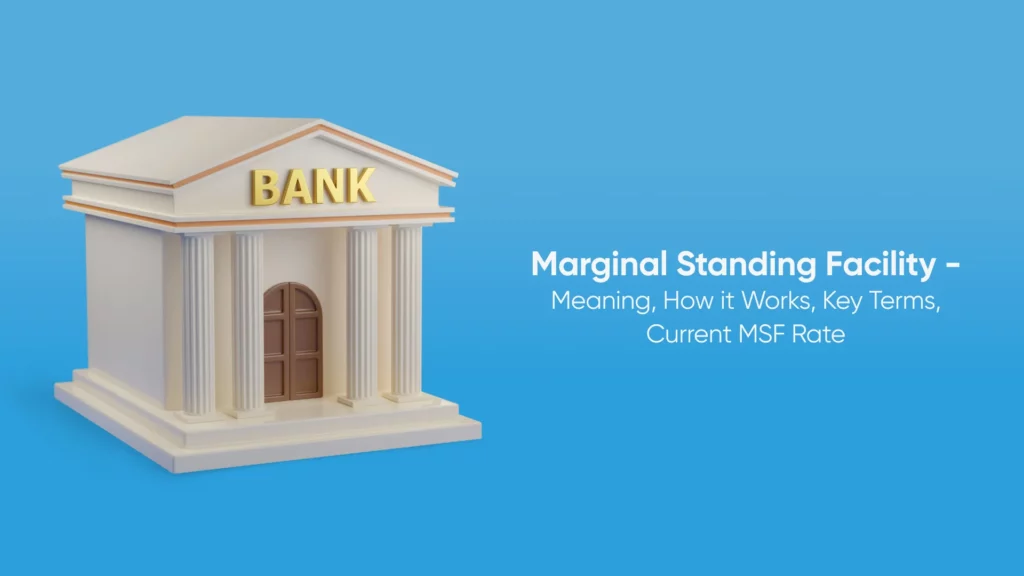Marginal Standing Facility - Meaning, How Does it Work?

The marginal standing facility (MSF) is a crucial monetary policy tool introduced by the Reserve Bank of India (RBI) during the 2011-12 financial reforms. This facility provides a safety net for scheduled commercial banks to address severe liquidity shortages. Essentially, the MSF allows banks to borrow overnight funds from the RBI by pledging government securities. This borrowing happens at a rate higher than the repo rate, known as the marginal standing facility rate.
In times of unforeseen liquidity crises, such as sudden withdrawals or inter-bank liquidity issues, banks can utilize the MSF to stabilize their operations without disrupting the financial system. This facility is available on all working days, providing a reliable personal loan for medical emergencies from different funding sources.
By understanding what is marginal standing facility rate and its operational mechanics, financial institutions can better manage financial stress, ensuring stability and continuity in their services.
Table of Contents
ToggleWhat is Marginal Standing Facility (MSF)?
The marginal standing facility is a financial tool introduced by the Reserve Bank of India to help banks manage short-term liquidity mismatches. When banks face sudden liquidity shortages and have exhausted their eligible securities for repo transactions, they can borrow overnight funds from the RBI using the MSF. This borrowing occurs at the marginal standing facility rate, which is typically higher than the repo rate. As of 2023, the MSF rate is 6.75%, slightly above the current repo rate of 6.50%.
The MSF allows banks to borrow up to 1% of their net demand and time liabilities (NDTL) by pledging government securities within the statutory liquidity ratio (SLR) limits. This facility ensures banks can access funds during emergencies without disrupting the financial system.
How Does Marginal Standing Facility Work?
The marginal standing facility functions as an emergency liquidity support system for banks. When a bank faces a critical liquidity shortage and cannot meet its funding needs through the common sources, it can turn to the MSF. Banks can borrow overnight funds from the Reserve Bank of India by pledging government securities. The borrowing under this facility is done at the marginal standing facility rate, which is typically set higher than the repo rate to discourage excessive reliance on this facility.
The MSF is particularly useful when banks need urgent liquidity, for instance, to meet sudden large withdrawals or to address inter-bank liquidity issues. This facility can indirectly influence the current personal loan interest rates and other lending rates by stabilizing the banking system. For example, during a liquidity crunch, banks may use the MSF to continue offering unsecured personal loans and urgent personal loans without significantly raising interest rates.
What Does Marginal Standing Facility Rate Mean?
The marginal standing facility rate is the interest rate at which the Reserve Bank of India lends money to scheduled commercial banks facing acute liquidity shortages. This rate is typically set higher than the repo rate, acting as a penalty rate to ensure that banks use this facility only in emergencies.
Understanding what is marginal standing facility rate is crucial for banks as it influences their borrowing costs during liquidity crises. The higher rate reflects the emergency nature of the facility, discouraging banks from relying on it for regular funding needs. This mechanism helps maintain overall financial stability by encouraging prudent liquidity management.
Eligibility Criteria for Marginal Standing Facility
Scheduled Commercial Banks: Only scheduled commercial banks that maintain a current account and a Subsidiary General Ledger (SGL) account with the Reserve Bank of India are eligible to use the marginal standing facility).
SLR Maintenance: Banks must maintain their statutory liquidity ratio holdings, which are government securities held as a percentage of their net demand and time liabilities. However, they can borrow up to 1% of their NDTL even if it means breaching the SLR requirement temporarily.
Collateral Requirements: Banks need to pledge approved government securities to access funds through the MSF. These securities act as collateral, ensuring the safety and security of the borrowed funds.
Usage Limit: The facility is designed for emergency situations, allowing banks to borrow overnight funds at the marginal standing facility rate. This helps banks meet urgent liquidity needs without significantly impacting current personal loan interest rates..
Current MSF Rate Comparison with Other Rates
Rate Type | Current Rate | Description |
Marginal Standing Facility (MSF) Rate | 6.75% | The marginal standing facility rate is the rate at which banks can borrow overnight funds from the RBI during emergencies by pledging government securities. |
Repo Rate | 6.50% | The repo rate is the rate at which the RBI lends money to commercial banks by purchasing their securities with an agreement to resell them later. |
Reverse Repo Rate | 6.25% | The reverse repo rate is the rate at which the RBI borrows money from commercial banks, providing a mechanism to absorb excess liquidity from the banking system. |
Bank Rate | 6.75% | The bank rate is the interest rate at which the RBI lends long-term funds to commercial banks. It often aligns with the marginal standing facility rate. |
Standing Deposit Facility (SDF) Rate | 6.25% | The SDF rate is the rate at which the RBI accepts funds from commercial banks without requiring collateral, used to absorb surplus liquidity. |
Also Read: Repo Rate vs Reverse Repo Rate: Know Differences
Benefits of Marginal Standing Facility
Emergency Liquidity Support: The marginal standing facility provides banks with an immediate source of funds during liquidity shortages. This ensures that banks can continue operations smoothly during financial stress.
Stabilizes the Banking System: By offering a reliable backup during emergencies, the MSF helps maintain stability in the banking system. This is crucial for maintaining confidence among depositors and investors.
Helps Manage Short-Term Liabilities: Banks can meet urgent demands, such as large withdrawals, by using the MSF. This ensures that banks can manage their short-term liabilities without significant disruptions.
Influences Interest Rates: The marginal standing facility rate indirectly affects current personal loan interest rates. By stabilizing the banking system, it helps keep lending rates consistent, benefiting customers seeking unsecured personal loans and urgent personal loans.
Flexible Collateral Use: Banks can pledge government securities within the statutory liquidity ratio (SLR) limits to access funds. This flexibility is essential during tight liquidity conditions.
Encourages Prudent Liquidity Management: The higher interest rate for MSF borrowing acts as a penalty, encouraging banks to manage their liquidity more sensibly and reduce reliance on emergency funding.
Limitations of Marginal Standing Facility
Higher Cost: The marginal standing facility rate is set higher than the repo rate, making it a costly option for banks. This higher rate is designed to discourage frequent use and ensure banks only resort to it during genuine emergencies.
Temporary Solution: The marginal standing facility provides only overnight funding, which means banks need to find more sustainable liquidity solutions quickly. It is not a long-term fix for ongoing liquidity issues.
Limited Borrowing Capacity: Banks can only borrow up to 1% of their net demand and time liabilities (NDTL) under the MSF. This limitation can be restrictive during severe liquidity crises where more substantial funding might be needed.
Collateral Requirement: Accessing funds through the MSF requires banks to pledge government securities. If a bank’s securities are already pledged or insufficient, it might face difficulties in availing funds through this facility.
Impact on Interest Rates: Although the MSF can stabilize the banking system, its high cost can lead to increased lending rates. This may affect current personal loan interest rates, making it more expensive for consumers seeking unsecured personal loans and urgent personal loans.
Potential for Over-Reliance: Despite the penalty rate, there is a risk that banks might become overly reliant on the MSF during frequent liquidity shortages, which can lead to poor liquidity management practices.
Conclusion
The marginal standing facility serves as a critical emergency liquidity tool for Indian banks, ensuring financial stability during crises. By allowing banks to borrow overnight funds at the marginal standing facility rate, set higher than the repo rate, the RBI encourages prudent liquidity management while providing a safety net.
Despite its benefits, including stabilizing the banking system and helping maintain consistent current personal loan interest rates, the MSF has limitations such as higher costs and limited borrowing capacity. These factors highlight the importance of using the MSF judiciously. Banks must balance their reliance on the MSF with robust liquidity management practices to avoid frequent recourse to this costly facility.
Frequently Asked Questions
What Is The Current MSF Rate?
The current marginal standing facility rate is 6.75% as of 2024. This rate is higher than the repo rate, which is set at 6.50%, reflecting its role as an emergency liquidity measure.
What Tools Are Used in Marginal Standing Facilities?
The primary tool used in the marginal standing facility is the pledging of government securities. Banks use these securities to borrow funds from the RBI at the marginal standing facility rate during liquidity shortages.
MSF Collateral: Is It Free?
No, collateral used in the marginal standing facility is not free. Banks must pledge government securities to access funds, which ensures that the borrowing is backed by secure assets.
Why Did the RBI Introduce MSF?
The RBI introduced the marginal standing facility in 2011-12 to provide banks with a reliable source of emergency liquidity during financial stress, ensuring stability in the banking system.
What Happens When MSF Rate Is Increased?
When the marginal standing facility rate is increased, borrowing costs for banks rise, leading to higher interest rates on loans such as current personal loan interest rates.
Who Finances MSF?
The marginal standing facility is financed by the Reserve Bank of India (RBI), which provides overnight funds to banks in exchange for government securities.
Who Works with MSF?
Scheduled commercial banks in India that maintain a current account and a Subsidiary General Ledger (SGL) account with the RBI are eligible to use the marginal standing facility.
How Often Is the MSF Rate Updated?
The marginal standing facility rate is updated periodically by the RBI, typically during its bi-monthly monetary policy reviews or as needed based on economic conditions.
YOU MAY ALSO LIKE





Search by posts
Recent post
Categories
- Blog (2)
- Credit History (25)
- Credit Line (7)
- Festive (3)
- Finance (15)
- Mutual Fund (9)
- Personal Loan (231)
- Tax (8)
- Zype (4)









